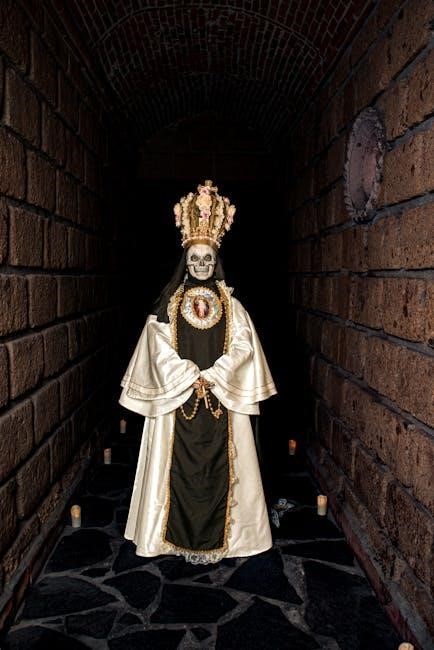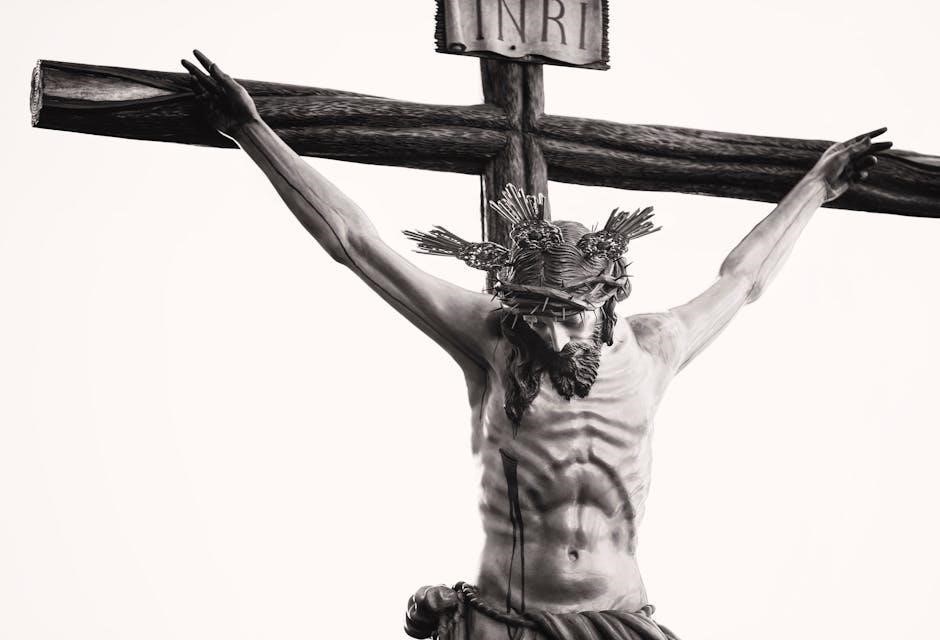
cronicas de una muerte anunciada pdf
Gabriel García Márquez’s Crónica de una muerte anunciada is a haunting tale of fate and honor, available in PDF formats, including a 2008 edition by Norma.
Overview of the Novel
Crónica de una muerte anunciada by Gabriel García Márquez is a concise yet profound novel blending magical realism with a tragic narrative. It recounts the foretold murder of Santiago Nasar, reconstructing events through multiple perspectives and testimonies. The story unfolds in the fictional town of Macondo, exploring themes of fate, honor, and societal norms. Márquez’s masterful storytelling weaves myth, tragedy, and empirical detail, creating a captivating tale of inevitability and human complexity.
Significance of the Title
The title Crónica de una muerte anunciada highlights the inevitability and predestination of Santiago Nasar’s death, serving as both a warning and a record of the events. It reflects the novel’s exploration of fate, societal expectations, and the inescapability of one’s destiny. The use of “Crónica” underscores the narrative’s formal, almost journalistic style, while “muerte anunciada” emphasizes the inexorable nature of the tragedy, central to the story’s themes and structure.
Author Background: Gabriel García Márquez
Gabriel García Márquez, a Colombian novelist and journalist, is renowned for his magical realism style. Born in 1927 in Aracataca, Colombia, he began his career as a journalist before gaining international acclaim with works like One Hundred Years of Solitude. His unique storytelling and exploration of human nature earned him the Nobel Prize in Literature in 1982. Márquez’s works continue to influence global literature, blending fantasy with gritty realism, leaving a lasting legacy in modern storytelling.

Historical and Cultural Context
Set in the fictional town of Macondo, inspired by García Márquez’s Colombian upbringing, the novel explores themes of honor, family, and societal expectations within a rich cultural framework.
Setting: The Fictional Town of Macondo
The fictional town of Macondo, a recurring setting in García Márquez’s works, serves as the backdrop for the novel. Its isolation and unique cultural identity create a sense of timelessness, blending tradition with the surreal. The town’s collective consciousness and rigid social norms amplify the tragedy, while its cyclical history and recurring fate mirror the inevitability of Santiago Nasar’s death. Macondo’s vivid, almost magical atmosphere immerses readers in the story’s world.
Cultural Themes in the Novel
The novel explores deep-rooted cultural themes such as honor, family, and societal expectations. The rigid moral codes of the town drive the plot, particularly the concept of honor tied to virginity and masculinity. The collective guilt and passive acceptance of fate reflect the cultural mindset of the community. These themes highlight the oppressive nature of traditional norms and their impact on individual lives, creating a tragic yet thought-provoking narrative.
Historical Influences on the Storyline
The novel is influenced by Colombia’s historical context, particularly the rigid social structures and patriarchal norms of the early 20th century. The Thousand Days’ War and the ensuing societal instability shaped the town’s conservative values and fatalistic mindset. García Márquez weaves these historical elements into the narrative, creating a backdrop where honor, family reputation, and violence are deeply intertwined, reflecting the era’s cultural and political tensions.

Plot Summary and Structure
The novel recounts Santiago Nasar’s tragic fate, unfolding non-linearly. His impending death is foretold, yet preventable. The narrative explores events before and after the murder, revealing societal tensions and individual flaws through multiple perspectives, creating a layered, suspenseful narrative.
The Tragic Fate of Santiago Nasar
Santiago Nasar, a wealthy bachelor, is doomed by a curse and societal expectations. His death is foretold yet preventable, symbolizing inevitability. The townspeople witness his fate unfold, highlighting the futility of resistance against destiny. His tragic end serves as a critique of rigid honor codes and the destructive power of unchecked societal norms.
The Failed Marriage of Bayardo San Román and Ángela Vicario
The marriage between Bayardo San Román and Ángela Vicario ends abruptly when Bayardo discovers Ángela is not a virgin. This betrayal sparks a chain of events leading to tragedy. The union, rooted in societal expectations, crumbles under the weight of honor and deception. Ángela’s defiance and Bayardo’s pride highlight the rigid gender roles and moral codes that dominate their world.
The Narrative Structure: Non-Linear Storytelling
The novel employs a non-linear narrative, unfolding through fragmented testimonies and multiple perspectives. The story begins with Santiago Nasar’s murder, then retraces events leading to his death. This structure creates suspense and underscores the inevitability of fate. García Márquez’s use of reverse chronology and overlapping narratives mirrors the cyclical nature of time in Macondo, blending past, present, and future seamlessly.

Major Themes Explored
The novel explores themes of honor, fate, and guilt, delving into the rigid social structures and cultural norms driving the characters’ tragic destinies.
Honor and Fate
In Crónica de una muerte anunciada, honor is a rigid and unyielding force driving the characters’ actions, while fate is an inescapable destiny. Santiago Nasar’s death is both a consequence of societal expectations and a tragic inevitability. The novel critiques the destructive power of honor, as it leads to the downfall of individuals and the moral decay of the community. Fate intertwines with honor, creating a cycle of vengeance and regret, ultimately highlighting the futility of resisting the inevitable.
Social Norms and Expectations
The novel explores the oppressive weight of social norms, particularly in the rigid expectations surrounding marriage, family honor, and gender roles. Ángela Vicario’s returned marriage and Santiago Nasar’s subsequent fate underscore the community’s adherence to these norms. The pressure to conform dictates actions, leading to tragic consequences, as individuals are forced to prioritize societal expectations over personal desires or moral accountability.
Moral Responsibility and Guilt
The novel examines the pervasive sense of moral responsibility and guilt that permeates the town. The Vicario brothers’ actions, driven by a sense of duty to restore family honor, highlight the ethical dilemmas. Meanwhile, the townspeople’s inaction and passive acceptance of fate reflect a collective guilt. The narrator’s exploration of these themes underscores the moral complexity, questioning who truly bears responsibility for Santiago Nasar’s tragic demise.

Character Analysis
The novel delves into the intricate personalities of Santiago Nasar, Ángela Vicario, and Bayardo San Román, exploring their roles in the tragic events and societal expectations that shape their fates.
Santiago Nasar: The Victim
Santiago Nasar, a wealthy, charismatic man, becomes the tragic victim of a predestined fate. His life is marked by solitude and a reputation for womanizing, which inadvertently sparks the events leading to his death. Despite his flaws, he remains a sympathetic figure, embodying the inevitability of fate and the rigid societal norms that condemn him. His death serves as a sacrifice to the town’s unyielding moral code.
Ángela Vicario: The Bride
Ángela Vicario, the bride, is a complex figure trapped by societal expectations. Her wedding ends in scandal when her lack of virginity is revealed, leading to public shame. Forced into a marriage she didn’t desire, Ángela embodies the stifling gender roles of her culture. Her silent endurance and eventual embroidery of her story symbolize her quiet resistance and internal strength amidst the turmoil.

Bayardo San Román: The Groom
Bayardo San Román, the groom, is a mysterious and charismatic figure whose marriage to Ángela Vicario ends in scandal. His pride and honor are deeply wounded when he discovers Ángela’s lack of virginity, leading him to abandon her. His actions set off a chain of tragic events, revealing his rigid adherence to societal norms. Despite his charm, Bayardo’s inability to accept reality underscores the novel’s exploration of honor and its devastating consequences.

Magical Realism in the Novel
The novel masterfully blends the surreal with the real, creating a captivating atmosphere where fantastical elements, like omens and exaggerated characters, coexist with everyday life seamlessly.
Elements of Magical Realism
The novel features vivid magical elements, such as the overwhelming smell of Santiago Nasar’s death and the yellow butterflies announcing Marquesa’s demise. These surreal details blend seamlessly with the mundane, creating a unique atmosphere. García Márquez uses these elements to explore fate, human flaws, and the inevitable, making the extraordinary feel ordinary within the story’s framework.
Symbolism and Metaphors
The novel is rich in symbolism, with the clock tower representing inevitable fate and the butterflies symbolizing impending doom. The knives and blood embody violence and sacrifice, while the wedding and marriage serve as metaphors for societal expectations and shattered illusions. These symbols weave together to highlight the novel’s themes of fate, honor, and human frailty, creating a layered narrative that transcends literal interpretation.
The Blending of Reality and Fantasy
In Crónica de una muerte anunciada, García Márquez masterfully blends reality and fantasy, creating a unique narrative texture. The town’s eerie, almost supernatural atmosphere contrasts with the brutal realism of Santiago’s fate. Dreams, omens, and unrealistic events coexist with mundane details, crafting a world where the extraordinary feels ordinary. This fusion enhances the novel’s mystical tone while grounding its tragic events in a relatable human experience, making the story both captivating and haunting.

Narrative Techniques
García Márquez employs non-linear storytelling, unfolding events out of chronological order. Multiple perspectives and a direct, involved narrator create depth, immersing readers in the tragic narrative.
Multiple Perspectives and Testimonies
The novel masterfully interweaves multiple testimonies, presenting diverse accounts of Santiago Nasar’s fate. Through fragmented narratives, García Márquez captures the complexity of truth, as each character’s perspective reveals partial insights. This technique challenges objectivity, emphasizing how collective memory shapes understanding. The voices of townspeople, family members, and even the victim himself create a layered, immersive experience, blurring fact and fiction. This narrative approach underscores the subjective nature of reality and the inevitability of destiny.
The Role of the Narrator
The narrator in Crónica de una muerte anunciada serves as a detached yet omniscient guide, piecing together fragmented testimonies to reconstruct Santiago Nasar’s doomed fate. By presenting multiple viewpoints, the narrator underscores the subjective nature of truth, blending factual details with mystical elements. This narrative technique heightens the sense of inevitability and moral inquiry, while the narrator’s neutral tone emphasizes the tragedy’s universality and the community’s complicity in the events. The narrator’s role is both observational and reflective, shaping the reader’s understanding of fate and responsibility.
Foreboding and Suspense
Gabriel García Márquez masterfully crafts foreboding and suspense in Crónica de una muerte anunciada, creating an atmosphere of inevitability. The novel’s non-linear structure reveals Santiago Nasar’s fate early on, yet the narrator’s deliberate pacing builds tension. Omens, such as the ill-fated marriage and the town’s ominous reactions, heighten the sense of impending tragedy. This narrative technique engages readers, making them complicit in the unfolding drama, despite knowing the outcome. Suspense is sustained through the slow revelation of motives and the inevitability of destiny.

Symbolism and Motifs
Crónica de una muerte anunciada explores motifs like fate, honor, and collective guilt. Symbols such as the town’s silence and animal imagery underscore impending doom and moral decay.
The Role of Time and Destiny
In Crónica de una muerte anunciada, time is cyclical and inevitable, mirroring the fate of Santiago Nasar. The non-linear narrative underscores destiny’s inescapability, as events unfold with a sense of preordained tragedy. The town’s awareness of the impending death, despite knowing the outcome, highlights the futility of altering fate. Time becomes a central motif, weaving together past, present, and future to create an unbreakable cycle of violence and moral reckoning.
The Significance of the Town’s Reaction
The town’s passive acceptance of Santiago Nasar’s fate reveals a deeper societal complicity. Despite knowing the impending tragedy, the community fails to intervene, symbolizing collective guilt and resignation. Their inaction underscores the novel’s critique of rigid social norms and the inevitability of fate. The town’s reaction mirrors the moral paralysis that perpetuates violence, highlighting the shared responsibility in Santiago’s death and the futility of individual agency against societal expectations.
Animals and Omens
In the novel, animals and omens serve as symbolic foreshadowing of Santiago Nasar’s fate. The falcon’s flight and the smell of jasmine signal impending tragedy. The butterflies surrounding Ángela represent her anguish and the inevitability of death. These elements blend reality with superstition, reflecting the town’s cultural beliefs and heightening the sense of doom. They also underscore the inescapability of destiny, central to the story’s tragic unfolding.
Reception and Legacy
The novel received widespread critical acclaim for its unique narrative style and exploration of fate. It solidified García Márquez’s reputation and remains a cornerstone of Latin American literature.
Critical Acclaim and Reviews
Crónica de una muerte anunciada has garnered widespread critical acclaim for its masterful blend of journalistic style and fictional narrative. Critics praise its exploration of fate, honor, and moral responsibility, with many considering it a literary masterpiece. The novel’s non-linear structure and rich characterization have been particularly highlighted, showcasing García Márquez’s unique storytelling prowess. Its enduring popularity underscores its profound impact on world literature and readers alike.
Impact on Latin American Literature
Crónica de una muerte anunciada significantly influenced Latin American literature by showcasing García Márquez’s mastery of magical realism. It contributed to the global recognition of Latin American authors and inspired a new generation of writers to explore rich, culturally vibrant narratives. The novella’s acclaim reinforced the region’s literary prominence, making it a cornerstone of contemporary Latin American fiction worldwide.
Adaptations and Translations
Crónica de una muerte anunciada has been adapted into films, plays, and TV series, with a notable 1987 Italian film directed by Francesco Rosi. The novella has been translated into numerous languages, broadening its global reach. Its availability in PDF format, including English and Spanish versions, has made it accessible to readers worldwide, further solidifying its literary impact and cultural significance across diverse audiences.

Availability and Formats
Crónica de una muerte anunciada is widely available in PDF format, accessible through online platforms and digital stores. Its popularity ensures it remains a sought-after download globally.
PDF Editions and Digital Availability
The novel Crónica de una muerte anunciada is widely available in PDF format, accessible through various online platforms such as Amazon Kindle, Google Books, and other digital retailers. Its digital presence ensures that readers can easily download and enjoy the book globally. The PDF editions are popular among readers due to their convenience and portability, making it a sought-after download for fans of magical realism and Latin American literature.
Print Editions and Publishers
The novel is widely available in print, published by renowned houses like Editorial La Oveja Negra and Editorial Sudamericana. International editions are distributed by publishers such as Harper Perennial and Penguin Books, ensuring global accessibility. Hardcover and paperback versions cater to both collectors and casual readers, making the physical copy a cherished possession for fans of García Márquez’s literary mastery.
Open-Source and Free Access
Accessing “Crónica de una muerte anunciada” as a free PDF is limited due to copyright protections. However, some open-source platforms and libraries may offer temporary access for educational purposes. Websites like Project Gutenberg or Internet Archive occasionally host such works, though availability varies by region. Always ensure compliance with local copyright laws when seeking free digital versions of this celebrated novel.
“Crónica de una muerte anunciada” remains a profound exploration of fate, honor, and human nature. Its legacy endures as a masterpiece of magical realism, leaving readers with deep reflections.
Final Thoughts on the Novel’s Significance
“Crónica de una muerte anunciada” is a masterful blend of tragedy, fate, and cultural critique. Its exploration of honor, guilt, and societal norms resonates deeply, offering timeless insights into human behavior; García Márquez’s use of non-linear storytelling and magical realism creates a haunting yet profound narrative. The novel’s enduring relevance lies in its ability to provoke reflection on moral responsibility and the inevitability of destiny, making it a cornerstone of Latin American literature.
Recommendation for Readers
“Crónica de una muerte anunciada” is a mesmerizing exploration of fate, honor, and societal expectations. García Márquez’s vivid prose weaves a tragic tale of inevitability and moral complexity. Readers will find themselves drawn into the intricate web of characters and events, questioning the boundaries between destiny and free will. A must-read for anyone interested in literary masterpieces that linger in the mind long after the final page.
Related Posts

pdf to ofx converter online free
Easily convert PDF files to OFX format online for free. No registration required, fast and secure conversion.

tu zona crypto book pdf
Dive into the world of cryptocurrency with our expert guide. Discover tips, tricks, and strategies for success in crypto trading and investing.

the attributes of god pdf
Explore the divine qualities of God through our comprehensive PDF guide. Download now and deepen your spiritual understanding!